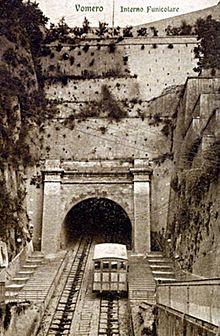Chiaia Funicular
| Chiaia Funicular | |
|---|---|

A view of the above-ground portion of the funicular in the late 19th century
|
|
| Overview | |
| Type | Funicular |
| Status | in use |
| Locale | Naples, Italy |
| Stations | 4 |
| Operation | |
| Opened | 1889 |
| Operator(s) |
|
| Technical | |
| Line length | 0.5 km (0.31 mi) |
| Track gauge | 1,435 mm (4 ft 8 1⁄2 in) |
The Chiaia Funicular (Italian: Funicolare Chiaia) is a funicular railway line that forms part of the public transport system for the city of Naples, Italy. Opened in 1889, the Chiaia Funicular is one of the oldest funicular railways in the world, and carries over half a million passengers per year.
The Chiaia Funicular serves four stations: Cimarosa Station, Palazzolo Station, Corso Vittorio Emanuele Station, and Regina Magherita Station. It primarily connects Piazza Vanvitelli, at the top of Vomero Hill, to Rione Amadeo. The line connects with Line 1 of the Naples Metro and the Central Funicular at Via Cimarosa, and with Line 2 at Via Regina Margherita. At Cimarosa the Chiaia is connected by a subway, permitting access to the metro without having to reach the street surface.
In the second half of the 19th century, the Vomero hill area to the northwest of Naples began to expand as a new residential area. Because of the steep incline of the hill it was difficult to access though. As a result, construction soon began on both the Chiaia and Montesanto Funicular cable railways. A local engineering firm, Le Officine Nazionali di Savigliano was granted the tender for all engineering, electric and mechanical work on the line. Nearly 300 metres shorter than the Montesanto inclien, the Chiaia Funicular was the first to be completed, opening to the public on 15 October 1889, and making it the third-oldest funicular railway in the world. Only the Giessbachbahn funicular in Switzerland (1879), and the Telegraph Hill Railroad in San Francisco, United States (1886), are older.
For the first eleven years of operation, the Chiaia funicular was powered by Escher Wyss steam engines, but in 1900 the line became electrified. The new twin-electric engines, provided by Brown Boveri & Co, gave 135 horsepower each, and greatly improved efficiency. In 1914 the original cars were replaced after 25 years of service, and two years later, in 1916, a third station, Palazzolo was inaugurated on the line. Until 1926 it only operated three stops, with the opening of Palazzolo Station (Parco Marcolini), delayed due to difficulty in accessing the area in which its construction was planned. OTIS elevators were included in its design to improve access to the platform at this station.
...
Wikipedia
